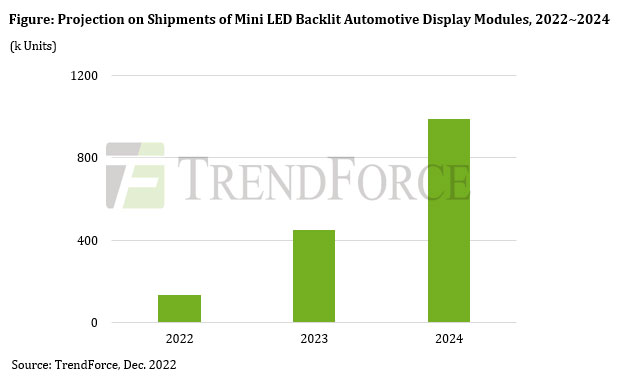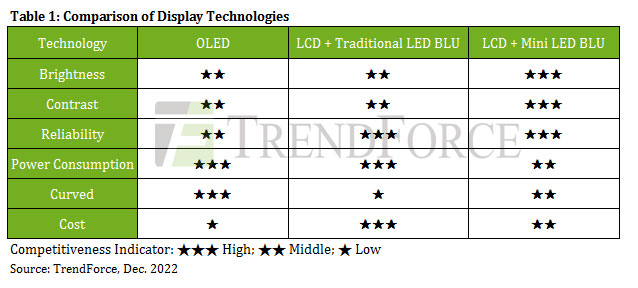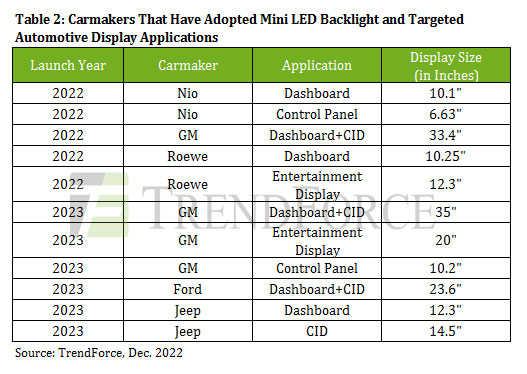News: Markets
21 December 2022
Mini-LED-backlit automotive display module shipments to grow from 140,000 in 2022 to 450,000 for 2023
Because of their use by European, Chinese and US carmakers, shipments of mini-LED-backlit display modules are estimated to total about 140,000 units in 2022, which can be considered to be the inaugural year for their adoption in the automotive industry, says TrendForce. In 2023, European and US carmakers such as Ford and Jeep are expected to gradually introduce the display technology to more of their models, driving shipments to 450,000 units, it forecasts. However, 2024 will be the year when shipments take off even more dramatically. By then, the further technological maturation of mini-LED backlights will attract the late adopters among carmakers, it is reckoned. Shipments are thus forecasted to reach almost 1 million units in 2024.

TrendForce lists four factors that are attracting carmakers to mini-LED-backlit displays. First, mini-LED backlights offers multiple dimming zones that can raise the brightness of a display above 1000 nits. High brightness is especially important for automotive applications because it helps to minimize glare from the outside environment. For instance, the strong light reflected from snow or emanating from the sun can interfere with the driver’s viewing of various displays inside a vehicle, creating safety risks. Increasing display brightness mitigates this problem.
Second, a direct-lit backlight solution featuring mini-LEDs can turn individual sections of a screen on or off selectively in accordance with the distribution of the light and dark parts of an image. With the traditional edge-lit solution, the entire screen is lit all the time. Carmakers can thus leverage mini-LED backlights to meet their energy-saving requirements, as a display system can consume about 10% less power by incorporating this technology.
Third, the development of automotive interior displays is trending towards larger sizes and integration. Direct-lit mini-LED solutions support not only the ongoing increase in display size but also the optical performance enabled by highly curved displays. Compared with the traditional edge-lit solutions, direct-lit mini-LED solutions offer better performance for curved automotive displays and are suitable for a wide range of automotive interior displays that differ in size and design.
Lastly, mini-LEDs are as highly reliable as conventional LEDs. Hence, they are expected to be the first choice for display backlight among carmakers.

As mentioned above, the advantages of direct-lit mini-LED solutions over edge-lit solutions include overall brightness, contrast, power consumption, support for the optical performance of a curved display, etc. Apart from these performance gains, mini-LED backlit displays are also much more reliable than organic light-emitting diode (OLED) displays for automotive applications. Priced between traditional edge-lit displays and OLED displays, mini-LED backlit displays deliver superior cost-to-performance ratio. Taking account of these benefits, carmakers are expected to be much more enthusiastic about using mini-LED backlit displays in the future.

Among carmakers, China’s Nio and Roewe have adopted mini-LED backlit display this year. They applied this solution first to the dashboard display (which places great demand on performance). Then, they applied it to the central information display (CID) and panel for air-conditioning (A/C) and volume controls. US carmaker General Motors (GM) has offered a 33.4-inch automotive display system with a mini-LED backlight. This system reflects the trend towards larger sizes and integration as it combines the dashboard display and CID.
Looking at the supply chain for mini-LED backlit automotive displays, Chinese carmakers have adopted automotive display systems that comprise mini-LED backlit display modules from BOE. European and US carmakers use mini-LED backlit display modules from AUO and Innolux. Regardless of suppliers, display modules are delivered to tier-1 integrators such as Bosch and CarUx so they can be assembled into display systems. Then, display systems are sent to car assembly plants for vehicle installation.









